
Q. What kinds of observation instruments are going to be on board?
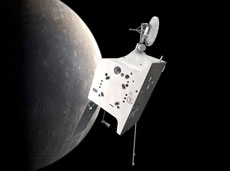
The Mercury Planetary Orbiter (MPO) (Courtesy of NASA)
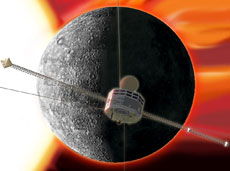
The Mercury Magnetospheric Orbiter (MMO) (Courtesy of NASA)
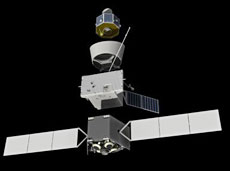
For the BepiColombo project, two orbiters (MPO and MMO) will be launched together. From top to bottom: MMO, the Sun Shield, MPO, and the Mercury Transfer Module. (Courtesy of ESA, EADS Astrium)
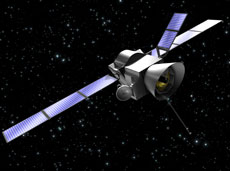
MPO and MMO flying toward Mercury (Artist's impression, courtesy of ESA)

BepiColombo consists of two orbiters. One of them is the Mercury Planetary Orbiter (MPO), which is being developed by the European Space Agency (ESA). This orbiter will mainly carry science instruments to investigate Mercury's surface topography and chemical composition. The MPO will be controlled using three-axis attitude control, as it is preferable to view the surface of Mercury in the same direction as the orbiter. The other orbiter is the Mercury Magnetospheric Orbiter (MMO), which is being developed by JAXA. It will carry science instruments to observe Mercury's magnetic field, magnetosphere and atmosphere, and interplanetary space environment near the Sun. The MMO's main objective is to observe plasma phenomena, so it has to be spinning. By making observations while spinning, the MMO will acquire information from all directions.
The most appropriate onboard science instruments for each orbiter's objectives were selected in an open competition in Japan and Europe. In order to promote joint development, many countries are working with the science instrument teams. JAXA's MMO will be equipped with six types of sensors to observe plasma particles, and there are six teams of Japanese and European researchers working on each type of sensor. For the plasma wave detector, the MMO will extend two pairs of thin electric field antennae stretching 15 m outward on each side. One pair will be made by Japan and the other by Sweden. 2 DC magnetic field sensors and 3-axis AC magnetic field sensor are installed on 2 extensible masts which length are approximate 5m. In addition, The information acquired by these sensors will be processed in several science instrments created cooperatively by Japanese and European scientists.
Q. What specific new technology does BepiColombo have?
In particular, I would like to mention the heat-resistant technology required to endure Mercury's harsh environment. The sunlight around Mercury's perihelion is 11 times stronger than near Earth. In addition, the satellite will be exposed to sunlight reflected and infrared radiation from Mercury's surface. The planet's surface reaches up to 400ºC - it's a very intense heat that cannot be ignored. Thus, we will cover the sides of the orbiter with mirrors to reflect the sunlight and to radiate the heat. We will also use heat insulators made of multiple layers of thin film to minimize the heat penetration. In places where we cannot place mirrors, we will use a special paint that will radiate heat very well but have low absorption rate for energy from sunlight. We are also developing flat antennae that don't collect light. Satellites usually use parabolic, high-gain antennae designed to collect not only radio waves, but also light. This causes the place where light is collected to become very hot, causing various problems. We will try to solve this by using flat antennae that will not collect light.
Mercury revolves very slowly toward the Sun. It is extremely hot during the day, but the temperature goes down to about -180ºC at night. As a result, when the orbiter goes into Mercury's shade, the temperature suddenly decrease. The orbiter has to be able to tolerate these drastic changes in temperature.
Q. Why is it necessary to explore Mercury now?
Due to its close proximity, the Sun hinders telescopic observations of Mercury from the ground, making it difficult to study the planet. Because of this, it can be observed for only about an hour before sunrise or after sunset, so we can't make enough observations from the ground. Since the Mercury 10 mission more than 30 years ago, Mercury has become a very popular research subject among those who study plasma and solid planets. There was tremendous interest in a mission to Mercury, but entering the orbit around Mercury is very difficult and requires a great deal of energy. It took a lot of time to turn this dream into reality. To inject the satellite into the orbit around Mercury, the explorer has to perform several swing-bys using the Moon, Earth, Venus and Mercury. By using the gravity of the planets, it will gradually get closer to the Hermean orbit while decelerating. Thus, it takes a lot of time and fuel - as much as it would take to travel to Saturn. BepiColombo will have the electric propulsion system used for the Asteroid Explorer Hayabusa, and is expected to reach Mercury in about six years.
Technological progress has finally allowed us to anticipate an explorer reaching Mercury, our dream destination.
Q. Was BepiColombo planned as an international project from the beginning?
No. Around 2000, Japan was investigating an orbiter similar to the MMO to research Mercury's magnetosphere. Since there were problems, such as the need for a big launch vehicle, and the working group was suspended halfway through. However, we reported our investigation at international researcher meetings. At about the same time, Europe was investigating a Mercury explorer similar to the current BepiColombo. The Europeans were already thinking about combining two orbiters, and one of them was very similar to the current MMO. When they found out that Japan was investigating a similar kind of explorer, they asked us to join them. As Japan had already developed a global reputation from the successful magnetosphere observation satellites Akebono and Geotail, the Europeans valued our input.
At that time, Japan had just started planetary exploration, so being part of an international project was a big bonus for us.
Q. What about cooperation from other countries outside Europe?
The project has mainly been sponsored by Japan and the European countries, but some American and other country researchers are involved in the development team of science instruments. In 2004, the United States took a step ahead of us and launched the Mercury Explorer Messenger. Messenger is scheduled to reach Mercury in 2011. It performed the first decelerating swing-by of Mercury in January 2008, and managed to capture images of parts of Mercury's surface that hadn't been observed by Mariner 10. As there are not many opportunities to go to Mercury, we are planning to exchange data with the Messenger team. The BepiColombo and Messenger projects are making ground observations of Mercury popular. Observation methods are being improved in order to study Mercury even during the day from observatories on Earth. The BepiColombo project team also intends to collaborate with ground-based observation teams. Recently, more papers on the exploration of Mercury are appearing at international research meetings. Following the swing-by of Mercury by Messenger early this year, I think more exploration missions to Mercury are bound to take place in the future.
Q. What is the difference between the U.S. Messenger probe and BepiColombo?
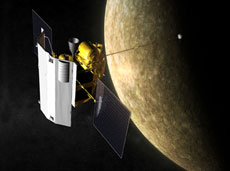
The Mercury Explorer Messenger (Courtesy of NASA)
NASA's Messenger is a mission under the Discovery Program, which is striving for less expensive and more efficient planetary exploration. Its main objective is to observe the topography of Mercury's surface and its chemical composition, but because this program wants a “fast and low-cost” mission, there several limitations. For example, Messenger's orbit is slanted to the northern hemisphere of Mercury. It also carries plasma particle instruments, yet the orbiter uses the three-axis attitude control system and sun-shield, since its main purpose is to investigate the solid planet. One side of Messenger is shielded from the Sun, and thus the probe can't observe plasma on the Sun's side, which will cause various limitations to the observation. However, we still expect to get detailed observation data on the high-latitude areas of Mercury's northern hemisphere.
Messenger performed a swing-by of Mercury in January 2008, exploring the planet for the first time in more than 30 years. It will make a second set of observations on another swing-by in one year's time. In 2011, it will be injected into the orbit around the Mercury and start continuous observations. The Messenger will certainly make many new discoveries, which I expect will raise a lot of new questions for us.
Based on Messenger's discoveries and the questions the mission raises, we can think about which areas we should explore with BepiColombo. Data from Messenger will enable us to set new observation targets, thus allowing us to achieve the best results. The data from Messenger could therefore have a major influence on BepiColombo's observations. We are looking forward to Messenger's discoveries.

The Mercury Planetary Orbiter (MPO) (Courtesy of NASA)

The Mercury Magnetospheric Orbiter (MMO) (Courtesy of NASA)

For the BepiColombo project, two orbiters (MPO and MMO) will be launched together. From top to bottom: MMO, the Sun Shield, MPO, and the Mercury Transfer Module. (Courtesy of ESA, EADS Astrium)

MPO and MMO flying toward Mercury (Artist's impression, courtesy of ESA)
BepiColombo consists of two orbiters. One of them is the Mercury Planetary Orbiter (MPO), which is being developed by the European Space Agency (ESA). This orbiter will mainly carry science instruments to investigate Mercury's surface topography and chemical composition. The MPO will be controlled using three-axis attitude control, as it is preferable to view the surface of Mercury in the same direction as the orbiter. The other orbiter is the Mercury Magnetospheric Orbiter (MMO), which is being developed by JAXA. It will carry science instruments to observe Mercury's magnetic field, magnetosphere and atmosphere, and interplanetary space environment near the Sun. The MMO's main objective is to observe plasma phenomena, so it has to be spinning. By making observations while spinning, the MMO will acquire information from all directions.
The most appropriate onboard science instruments for each orbiter's objectives were selected in an open competition in Japan and Europe. In order to promote joint development, many countries are working with the science instrument teams. JAXA's MMO will be equipped with six types of sensors to observe plasma particles, and there are six teams of Japanese and European researchers working on each type of sensor. For the plasma wave detector, the MMO will extend two pairs of thin electric field antennae stretching 15 m outward on each side. One pair will be made by Japan and the other by Sweden. 2 DC magnetic field sensors and 3-axis AC magnetic field sensor are installed on 2 extensible masts which length are approximate 5m. In addition, The information acquired by these sensors will be processed in several science instrments created cooperatively by Japanese and European scientists.
Q. What specific new technology does BepiColombo have?
In particular, I would like to mention the heat-resistant technology required to endure Mercury's harsh environment. The sunlight around Mercury's perihelion is 11 times stronger than near Earth. In addition, the satellite will be exposed to sunlight reflected and infrared radiation from Mercury's surface. The planet's surface reaches up to 400ºC - it's a very intense heat that cannot be ignored. Thus, we will cover the sides of the orbiter with mirrors to reflect the sunlight and to radiate the heat. We will also use heat insulators made of multiple layers of thin film to minimize the heat penetration. In places where we cannot place mirrors, we will use a special paint that will radiate heat very well but have low absorption rate for energy from sunlight. We are also developing flat antennae that don't collect light. Satellites usually use parabolic, high-gain antennae designed to collect not only radio waves, but also light. This causes the place where light is collected to become very hot, causing various problems. We will try to solve this by using flat antennae that will not collect light.
Mercury revolves very slowly toward the Sun. It is extremely hot during the day, but the temperature goes down to about -180ºC at night. As a result, when the orbiter goes into Mercury's shade, the temperature suddenly decrease. The orbiter has to be able to tolerate these drastic changes in temperature.
Q. Why is it necessary to explore Mercury now?
Due to its close proximity, the Sun hinders telescopic observations of Mercury from the ground, making it difficult to study the planet. Because of this, it can be observed for only about an hour before sunrise or after sunset, so we can't make enough observations from the ground. Since the Mercury 10 mission more than 30 years ago, Mercury has become a very popular research subject among those who study plasma and solid planets. There was tremendous interest in a mission to Mercury, but entering the orbit around Mercury is very difficult and requires a great deal of energy. It took a lot of time to turn this dream into reality. To inject the satellite into the orbit around Mercury, the explorer has to perform several swing-bys using the Moon, Earth, Venus and Mercury. By using the gravity of the planets, it will gradually get closer to the Hermean orbit while decelerating. Thus, it takes a lot of time and fuel - as much as it would take to travel to Saturn. BepiColombo will have the electric propulsion system used for the Asteroid Explorer Hayabusa, and is expected to reach Mercury in about six years.
Technological progress has finally allowed us to anticipate an explorer reaching Mercury, our dream destination.
Q. Was BepiColombo planned as an international project from the beginning?
No. Around 2000, Japan was investigating an orbiter similar to the MMO to research Mercury's magnetosphere. Since there were problems, such as the need for a big launch vehicle, and the working group was suspended halfway through. However, we reported our investigation at international researcher meetings. At about the same time, Europe was investigating a Mercury explorer similar to the current BepiColombo. The Europeans were already thinking about combining two orbiters, and one of them was very similar to the current MMO. When they found out that Japan was investigating a similar kind of explorer, they asked us to join them. As Japan had already developed a global reputation from the successful magnetosphere observation satellites Akebono and Geotail, the Europeans valued our input.
At that time, Japan had just started planetary exploration, so being part of an international project was a big bonus for us.
Q. What about cooperation from other countries outside Europe?
The project has mainly been sponsored by Japan and the European countries, but some American and other country researchers are involved in the development team of science instruments. In 2004, the United States took a step ahead of us and launched the Mercury Explorer Messenger. Messenger is scheduled to reach Mercury in 2011. It performed the first decelerating swing-by of Mercury in January 2008, and managed to capture images of parts of Mercury's surface that hadn't been observed by Mariner 10. As there are not many opportunities to go to Mercury, we are planning to exchange data with the Messenger team. The BepiColombo and Messenger projects are making ground observations of Mercury popular. Observation methods are being improved in order to study Mercury even during the day from observatories on Earth. The BepiColombo project team also intends to collaborate with ground-based observation teams. Recently, more papers on the exploration of Mercury are appearing at international research meetings. Following the swing-by of Mercury by Messenger early this year, I think more exploration missions to Mercury are bound to take place in the future.
Q. What is the difference between the U.S. Messenger probe and BepiColombo?

The Mercury Explorer Messenger (Courtesy of NASA)
Messenger performed a swing-by of Mercury in January 2008, exploring the planet for the first time in more than 30 years. It will make a second set of observations on another swing-by in one year's time. In 2011, it will be injected into the orbit around the Mercury and start continuous observations. The Messenger will certainly make many new discoveries, which I expect will raise a lot of new questions for us.
Based on Messenger's discoveries and the questions the mission raises, we can think about which areas we should explore with BepiColombo. Data from Messenger will enable us to set new observation targets, thus allowing us to achieve the best results. The data from Messenger could therefore have a major influence on BepiColombo's observations. We are looking forward to Messenger's discoveries.